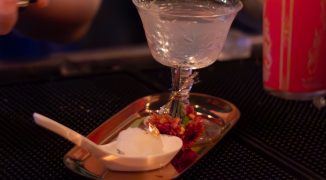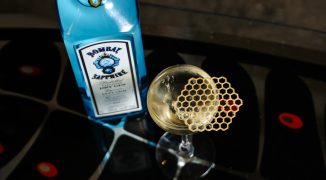It’s easy to churn out a low-ABV spritz when the sun is shining warmly and patrons are donning sunglasses and flip flops on the patio. Yet there’s a growing demand for lower alcohol cocktails throughout the year, including when scarves and snowshoes are being put to use instead. So what’s the secret for making low ABV cocktails work in the winter?
According to Jim Kearns of Slowly Shirley in New York City, one of the reasons for the surge in popularity for all things low ABV to begin with is the versatility of the category. “Low ABV cocktails tend to be a great option at any time, especially before eating and with food, since they pack less of a wallop, both in terms of booze and price point,” he says.
The fact that they pack less of a wallop is key as well, both for bars looking to steer clear of over-serving customers, as well as for those customers who have no interest in being over-served to begin with. “I think folks want to be able to go out and have a couple beverages while still being coherent and able to drive home,” says Bryan Gall of Portland, Oregon’s Bacchus Bar. “People who may not go out for cocktails because of the high alcohol content can now go out and enjoy drinks with friends.”
Even with the category receiving increased attention, there’s still some skepticism. “I consider the creation of low ABV cocktails to be more challenging and [to] require even more care because in and of themselves, they tend to be a tougher sell,” says Andrea Tateosian of Urbana in Washington, D.C. “So when creating a recipe, I want to surprise guests with how complex, balanced and fun they can be. If we are going to convert skeptics, phoning it in is not an option.”
That’s also one reason that low ABV drinks are often bartender favorites. “I personally prefer low proof drinks in general, and they are my favorite cocktails to concoct,” says Tateosian. “I relish the opportunity to introduce patrons to something that I personally enjoy so much.”
In many cases though, lower proof drinks prove to be crowd-pleasers that stand out on their own merits, regardless of alcoholic strength. “We’ve actually made the low ABV section the opening page on our cocktail menu,” says Kearns. “And the first drink on it, the Village Bicycle, is by far our best-selling drink of all time, both because of its location on the menu and because it contains pretty universally appealing, recognizable ingredients.” The drink is made with either vodka or gin, along with blanc vermouth, kaffir lime, lychee, ginger and lemon.
“In general I have witnessed less interest in alcohol content and more interest in flavors and experimentation,” adds Tateosian. “An interesting combination of ingredients or a familiar flavor can lure guests to try something low ABV without even realizing it.
“Most guests who order the Spice Oddity do so because the idea of espresso and passion fruit together interests them. The proof has nothing to do with it,” she continues, referring to her cocktail named in homage to David Bowie’s “Space Oddity.” It’s made with Capitoline white vermouth, a local blanc vermouth made in D.C., lime juice, espresso syrup and passion fruit puree, served with a cayenne-salt dipped lime wedge.
As far as cold-friendly low ABV drinks go, it’s all about finding the right starting ingredients. “It’s a matter of tweaking drinks to the season,” says Gall. “I would also put port in that category,” he continues, while referencing other favorites such as fig, cardamom and anise.
“Low ABV products like Amontillado and Oloroso sherry, Punt e Mes, dark beer and hard cider are positively redolent of fall and winter flavors,” says Tateosian. “A Port and Porter Flip is rich, nutty and has a weightiness that holds its own against any boozy eggnog.”
Plus, the full bar and all of your favorite cocktail go-tos are still available when deployed in the right manner, to add flavor as a modifier rather than serving as a base. “Even small amounts of aged rum, American whiskey, or Islay scotch can make any drink seem like a great cold weather cocktail,” says Kearns.
Continuing with that line of thinking, while sherry and vermouth may be the most commonly deployed low ABV ingredients, there’s no reason to stop there. “As a self-diagnosed sherry fiend, I love what sherry can do to a cocktail,” says Tateosian. “It is an incredibly versatile category, and both sherry and vermouth can provide depth and flavor to cocktails in high volume without greatly increasing its ABV. However, there are other low proof products that are being used more and more frequently in low proof cocktails.”
Kearns says that while he also, “love[s] me some sherry,” he has a full repertoire of low ABV favorites. “My other go-tos would definitely have to include vermouth, sake, amari and aperitifs such as Aperol, Cappelletti and Campari.”
From there the possibilities are endless. “Wine cocktails are slowly gaining traction as well,” says Tateosian. “Rosé-tonics all day.”
When sticking with sherry though, Gall also offers some interactivity which allows a chance for customers to learn about the category along the way. The Spanish Dilly is based on a drinker’s choice of sherry, either Amontillado, Fino or “East India,” which is a sweetened Oloroso, along with blood orange puree, lemon juice, simple syrup and fresh dill and thyme.
With bartenders like these offering creative year-round and seasonal low proof libations, expect the movement to pick up even more speed in the New Year. “I think low ABV cocktails are still a fairly new trend, but I would expect to see a lot more options in 2017,” says Gall.




